
|
|
|
|
BY: SUN STAFF
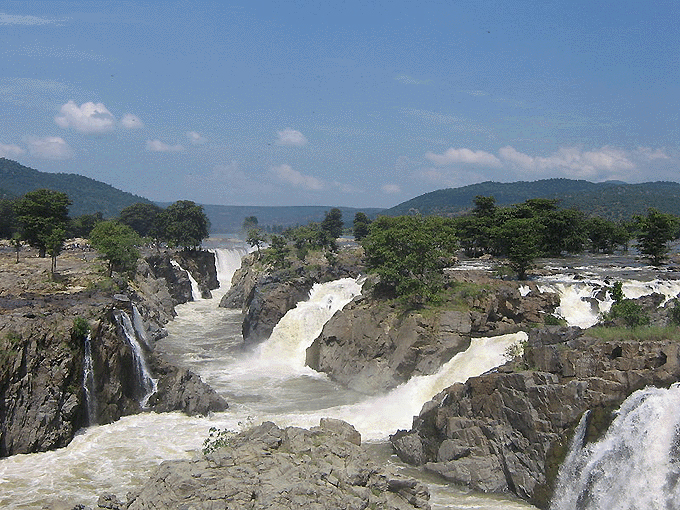
Hogenakkal Waterfalls on River Kaveri, Tamil Nadu Jan 29, CANADA (SUN) — A serial exploration of the holy sites visited by Lord Caitanya. Kaveri-tira
In Caitanya-caritamrta Madhya lila 9, we find HDG Srila Bhaktivinoda Thakur's summary of the holy places visited by Lord Caitanya Mahaprabhu in South India. Included among them is Kaveri-tira, which refers to the banks of the Kaveri River.
Madhya lila 9, Summary: "After leaving Vidyanagara, Sri Caitanya Mahaprabhu visited such places of pilgrimage as Gautami-ganga, Mallikarjuna, Ahovala-nrsimha, Siddhavata, Skanda-ksetra, Trimatha, Vrddhakasi, Bauddha-sthana, Tirupati, Tirumala, Pana-nrsimha, Siva-kanci, Visnu-kanci, Trikala-hasti, Vrddhakola, Siyali-bhairavi, Kaveri-tira and Kumbhakarna-kapala."
Mahaprabhu's pastimes with the Kaveri River are several, as mentioned in Madhya Lila:
Madhya 9.74
After visiting the temple of Siyali-bhairavi [another form of the goddess Durga], Sri Caitanya Mahaprabhu, the son of mother Saci, went to the bank of the river Kaveri.
PURPORT After next visiting Lord Shiva's temple at Go-samaja, Mahaprabhu went on to Vedavana, then to Lord Visnu's temple at Devasthana, then Kumbhakarna-kapala and Siva-ksetra. In Madhya 9.79 we read:
"After visiting the holy place named Siva-ksetra, Caitanya Mahaprabhu arrived at Papanasana and there saw the temple of Lord Visnu. Then He finally reached Sri Ranga-ksetra."
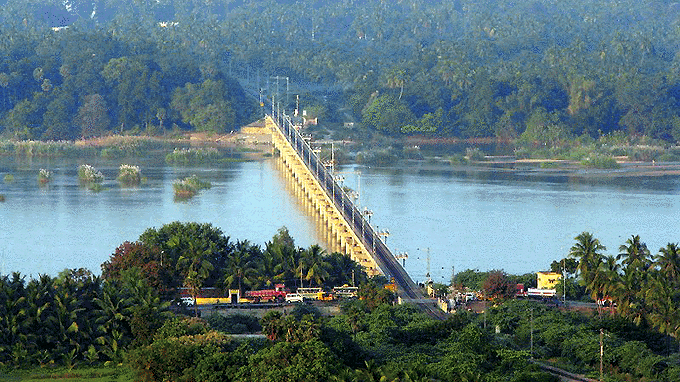
Kaveri river at Thiruchirapalli Among the Lord's most famous pastimes associated with the Kaveri River is His stay at the home of Vyenkatta Bhatta and his son, Sri Gopal Bhatta Goswami. Vyenkatta Bhatta was a brahmana resident of Shri Rangam, and was initiated in the Srivaisnava Sampradaya. The city of Shri Rangam is located on the Kaveri River, in the district of Tanjore, about ten miles west of Kumbhakonam. In his purport to Caitanya-caritamrta Madhya lila, 9.79, Srila Prabhupada describes it as follows:
"The Shri Rangam temple is the largest in India, and there are seven walls surrounding it. There are also seven roads leading to Shri Rangam. The ancient names of these roads are Dharma, Rajamahendra, Kulashekhara, Alinadana, Tiruvikrama, Tirubidi and Ada-iyavala-indana. The temple was founded before the reign of Dharmavarma, who reigned before Rajamahendra. Many celebrated kings like Kulashekhara and others such as Alabandaru, resided in the temple of Shri Rangam. Yamunacharya, Shri Ramanuja, Sudarshanacharya, and others also supervised this temple." Although the River Kaveri (Cauvery) flows for a distance of 475 miles, we know that the place where Lord Caitanya took bath during this particular pastime was the Kaveri at Shri Rangam. Before his famous meeting with Vyenkatta Bhatta, Lord Caitanya's bathing pastime is described in Madhya 9.79-86:
shri-ranga-ksetre tabe karila gamana kaverite snana kari dekhi ranganatha stuti pranati kari manila krtartha premaveshe kaila bhauta gana nartena dekhi camatkara haila saba lokera mana shri vaishnava eka—vyenkatta bhatta nam prabhure nimantrana kaila kariya sammana nija-ghare laya kaila pada praksalana sei jala kaila sa-vamse bhakshana bhiksha karaya kichu kaila nivedana caturmasya asi prabhu haila upasanna caturmasya kripa kari raha mora ghare krishna-katha kahi kripaya uddhara amare tanra ghare rahila prabhu krishna-katha rasa bhatta-sange gonaila sukhe cari mase. "After visiting the holy place named Shiva-ketra, Chaitanya Mahaprabhu arrived at Papanashana and there saw the temple of Lord Vishnu. Then He finally reached Shri Ranga-kshetra. After bathing in the river Kaveri, Shri Chaitanya Mahaprabhu saw the temple of Ranganatha and offered his ardent prayers and obeisances. Thus He felt Himself successful. In the temple of Ranganatha, Shri Chaitanya Mahaprabhu chanted and danced in ecstatic love of Godhead. Seeing His performance, everyone was struck with wonder. One Vaishnava known as Vyenkatta Bhatta then invited Shri Chaitanya Mahaprabhu to his home with great respect. Shri Vyenkatta Bhatta took Shri Chaitanya Mahaprabhu to his home. After he washed the Lord's feet, all the members of his family drank the water. After offering lunch to the Lord, Vyenkatta Bhatta submitted that the period of Chaturmasya had already arrived. Vyenkatta Bhatta said, 'Please be merciful to me and stay at my house during Chaturmasya. Speak about Lord Krishna's pastimes and kindly deliver me by your mercy.' Shri Chaitanya Mahaprabhu remained at the house of Vyenkatta Bhatta for four continuous months. In this way, The Lord passed His days in great happiness, enjoying the transcendental mellow of discussing Lord Krishna's pastimes."
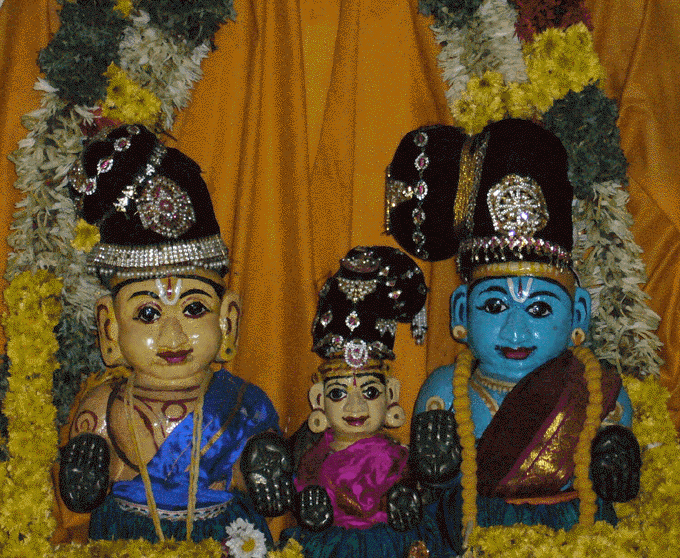
Lord Caitanya's Jagannatha Deities at Sri Rangam A few months ago, the Sun did a feature story on the amazingly beautiful Lord Jagannatha Deities that Lord Caitanya carved while staying in the asrama of Vyenkatta Bhatta, which you can read here.
Continuing on in Madhya Lila, we hear of the Lord's regular pastimes of taking bath in the Kaveri:
Madhya 9.86-89 "Sri Caitanya Mahaprabhu remained at the house of Venkata Bhatta for four continuous months. The Lord passed His days in great happiness, enjoying the transcendental mellow of discussing Lord Krsna's pastimes.
While there, Sri Caitanya Mahaprabhu took His bath in the river Kaveri and visited the temple of Sri Ranga. Every day the Lord also danced in ecstasy.
The beauty of Lord Caitanya's body and His ecstatic love of God were witnessed by everyone. Many people used to come see Him, and as soon as they saw Him, all their unhappiness and distress vanished.
Many hundreds of thousands of people from various countries came to see the Lord, and after seeing Him they all chanted the Hare Krsna maha-mantra."
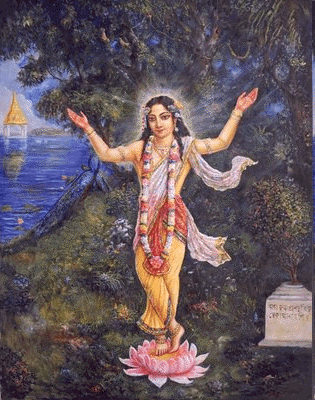
Lord Caitanya Mahaprabhu
Further Bathing Pastimes of Mahaprabhu in the Kaveri
In his commentary on Caitanya-caritamrita, Srila Bhaktivinoda Thakur writes about Venkata Bhatta, Trimalla Bhatta and Prabodhananda Saraswati, who were previously acaryas of the Shri-sampradaya. Previously, these three brothers had beren worshipers of Laksmi-Narayana, but they were converted to the worship of Radha and Krishna by the grace of Lord Chaitanya Mahaprabhu. Krishnadas Kaviraj Goswami describes their conversion in his Caitanya-caritamrita.
In Sri Bhakti-ratnakara, we find numerous descriptions of the pastimes of these three brothers, including their association with Caitanya Mahaprabhu during his South India travels. From this narration we can understand that Lord Caitanya bathed repeatedly in the Kaveri:
"Gauracandra was the wealth of Tirumalaya, Venkata and Prabodhananda's lives. The three of them were worshipers of Lakshmi Narayan whose preferences changed to Radha and Krishna as a result of the Lord's mercy... The three of them wondered how they could continue living in the Lord's absence; they wondered who would joke with them and who would accompany them to the Kaveri to bathe in the morning... After four months, when the Lord left, the three brothers began to cry. Mahaprabhu embraced the three brothers and tried to console them. Some people glorified Prabodhananda's virtues and thus he was given the title Saraswati by which he was known everywhere. Sri Krishna Chaitanya is the Supreme Lord and Supreme Absolute Truth. He was so dear to Prabodhananda that even in his dreams he knew nothing else." Bhakti-ratnakara 1.83-4, 128-9, 133, 135, 149, 150
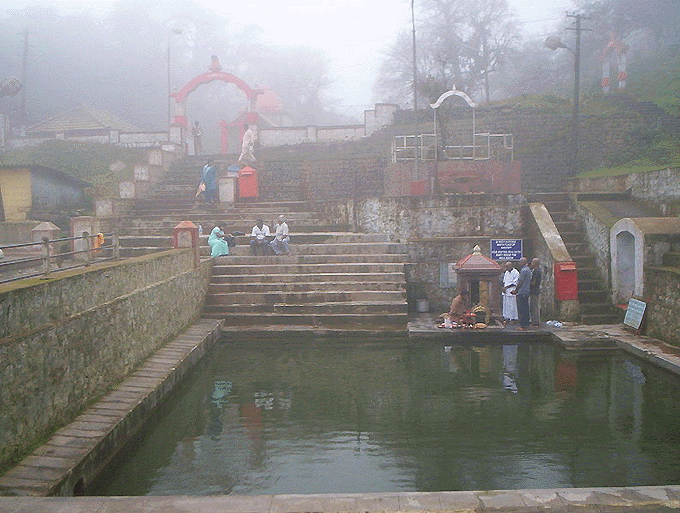
Origination of the River Kaver at Talakaveri Nityananda Prabhu at River Kaveri
In Srila Vrndavana dasa's Sri Chaitanya Bhagavat, Adi Lila 9, we read that during his twenty years of pilgrimage prior to meeting Sri Madhavendra Puri and Lord Caitanya, Nityananda Prabhu visited many of the same places Mahaprabhu visited. Like Lord Caitanya, in the South he gave darshan to Lord Shiva and Parvati, and later stopped at the River Kaveri and Sri Rangam.
"In Madurai he visited the temple of Lord Kartika and then went on to the place known as Sri Prabat. There, in a massive and impressive temple, His devotees Lord Siva and Parvati were being opulently worshipped as a brahmin and his wife. Lord Siva and Parvati recognized Lord Nityananda as their worshipable Supreme Lord. The original Sankarsana appeared before them as a pilgrim in mendicant's dress. Siva and Parvati joyfully received their exalted guest and attended to him affectionately. Parvati cooked palatable dishes for His satisfaction and in reciprocation Sri Nityananda offered them his obeisances. Only Lord Krishna, knows the confidential topics that transpired between them, but thereafter Lord Nityananda went to the Dravida territory.
He travelled through different pilgrimage spots touching upon the places of Vyenkatanatha, Kamakosthipuri and Kanci, arriving at last at the sacred river Kaveri. Then He proceeded to the famous holy place of Sriramgam where merciful Lord Sri Ragunatha received opulent worship from His devotees."
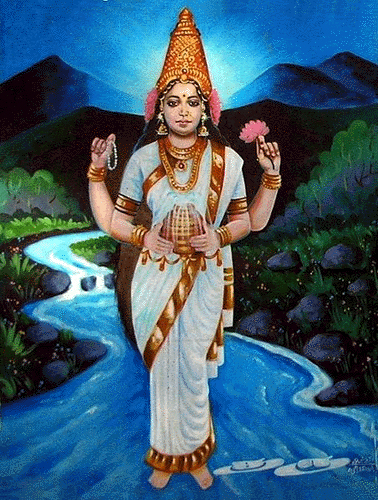
Goddess Kaveri The River Kaveri
There are several stories about how the River Kaveri came into being. In chapters 11-14 of the Skanda Purana, which is also known as the Kaveri Purana, there is a narration of the churning of the milk ocean. After the elixir was successfully given over to the Devatas, Mohini retired to Brahmagiri and turned into a rocky cave. Later, a great sage named Kavera came to Brahmagiri to meditate. Being lonely, he prayed to Lord Brahma for a child. Brahma gave him Lopamudre for a daughter, and she was renamed Kaveri, after her father.
The daughter Kaveri, wishing for her father to have all success in life, also prayed to Brahma, asking to become a river that would flow through the lands, bringing prosperity to her father and all the people. She also asked to be so pure that others could bathe in her waters to relieve the burden of their sinful activities. Lord Brahma granted her wishes. Goddess Kaveri later had various pastimes with the sage Agastya, who married her. Breaking his marital agreement with her, however, Kaveri went underground, eventually flowing out into the Bay of Bengal.
There are three river islands in the Kaveri which have an important Vaishnava heritage. The temples on each of these islands are the residence of Lord Visnu in His reclining posture, lying on Sesanaga. These three temples are Adi Ranga, Madya Ranga, and Anthya Ranga.
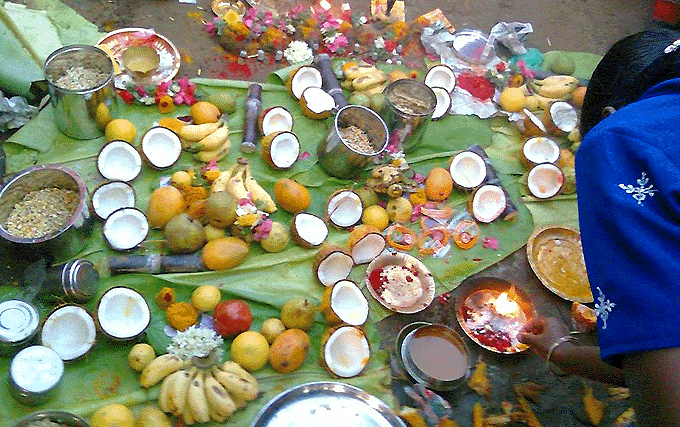
Worship of River Kaveri at Tiruchirappalli
| |